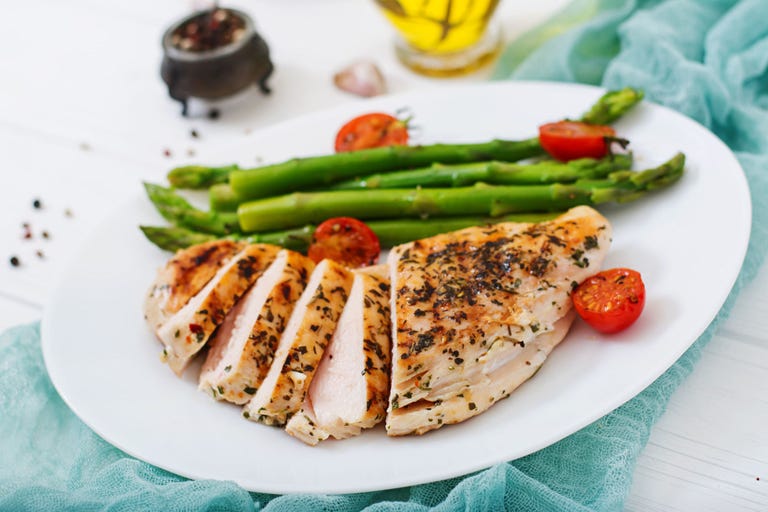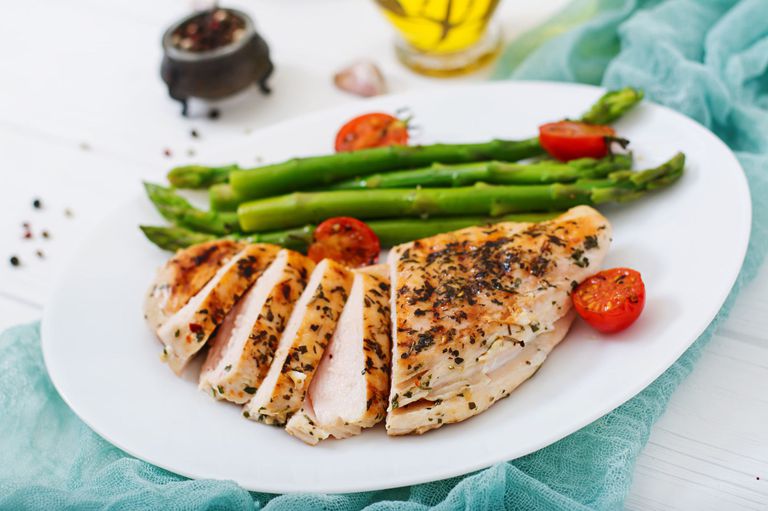How to Get the Best Nutrition from Chicken Breasts

Skinless, grilled chicken breasts appear in just about every healthful eating plan, but confusion about poultry — no hormones added! white striping! routine antibiotics! — might leave you standing mystified in the meat aisle. Have no fear: Chicken breasts are an excellent source of protein that’s low in saturated fat, not to mention the bonus antioxidants and nutrients. Get the real answers on this diet staple below, and start planning your weeknight menu worry-free.
NUTRITION STATS
Serving Size: 3 ounces grilled boneless chicken breast
- 128 calories
- 2.7 grams of fat (4% DV)
- 0.8 g saturated fat (4% DV)
- 88 mg cholesterol (29% DV)
- 26 g protein (52%)
- .983 mg B6 (49% DV)
- .38 mg iron (2% DV)
- 28.9 mg magnesium (7% DV)
- 219.3 mg phosphorus (22% DV)
- 332.35 mg potassium (7% DV)
- 0.77 mg zinc (5% DV)
Not sure what kind of chicken to pick? Ahead, get the low-down on shopping for and preparing chicken — without the B.S.
ARE CHICKEN BREASTS BETTER FOR YOU THAN OTHER PARTS OF THE CHICKEN?
Chicken breasts are the leanest parts of the bird, packing about 1 to 1.5g of saturated fat per 3.5-ounce serving and they’ve got more protein than skinless chicken thighs. That said, thighs have more iron, making them another nutritionally-dense choice to keep in your menu rotation.
Skinless breasts, thighs, and drumsticks all hover around the 170 calories per serving. Wings are the fattiest and most caloric part of the bird at about 210 calories and 11g saturated fat each — not including the skin.
Bottom line: All skinless chicken is a good source of protein that’s lower in saturated fat than some red and processed meats. It’s the less-healthy choices that happen in the kitchen (ahem, deep-fried chicken) with high-fat, high-sodium sauces, breadings, and marinades. Instead, dress up a skinless bird with poultry seasonings, rubs, and spices that stay around or under 140mg of sodium per serving.
WHAT NUTRIENTS ARE IN CHICKEN BREAST?
Chicken breasts are a great source of the essential nutrient choline, providing 13% of your daily value in one serving. Choline is necessary for cognition, memory, mood, muscle control, and other neurological functions. It’s also crucial to fetal brain development and protective against non-alcoholic fatty liver disease (NAFLD) and heart disease.
HOW CAN I TELL IF THE CHICKEN I’M BUYING WAS RAISED WITH HORMONES OR ANTIBIOTICS?
No hormones are ever used in the raising of chickens. Antibiotics were used in the livestock production to prevent the spread of illness, but the FDA banned routine antibiotics in 2017. The practice had garnered criticism for potential growth hormone-promoting effects.
Livestock can still receive antibiotics as a treatment for infection. Only organic meat and poultry can never receive antibiotics at any point, so if you’re concerned pick meat labeled “USDA Organic.”
IS THERE A DIFFERENCE BETWEEN FRESH AND FROZEN CHICKEN BREAST?
Opting for fresh poultry when you can is optimal since nutrients may be lost during freezing and thawing. However, both are still good choices. It’s more essential that you check frozen meals made with chicken for key nutritional stats, like real, whole foods in the ingredients list (not lots of flavor additives!) and 300- to 400-calorie servings with less than 500mg of sodium and 5g of saturated fat.
SHOULD I BE WORRIED ABOUT “WHITE STRIPING?”
Some concern was raised in early 2017 about “white striping,” a condition where white stripes appear in chicken breast as a result of a perceived “growth spurt.” The worry was that more white stripes meant that the chicken had a higher fat content with less protein. That said, there’s no cause for concern. Chicken is still a nutrient-dense source of lean protein that can be enjoyed in many different ways. Just pick the meat that looks best to you when purchasing.
CAN CHICKEN BREAST GIVE YOU FOOD POISONING?
All raw agricultural products can pose a possible human health threat when contaminated with certain bacteria. In chicken, this risk comes from human mishandling, not the poultry or bacteria themselves. Regardless of third-party verifications like USDA Organic, eating improperly prepared or stored meat can lead to foodborne illness. Get the National Chicken Council’s guidelines for optimal food safety here.
WHAT ARE THE BEST WAYS TO MAKE CHICKEN BREAST TASTE GOOD?
Enjoy chicken breasts roasted solo, grilled with a marinade, tossed in salads, and sliced on sandwiches. Regardless, broiler or rotisserie versions beat the pre-packaged kind that’s preserved with added sodium. Since the breast itself naturally includes some salt, additional flavorings can drive up that sodium content — quickly! Check labels for sauces, seasonings, and toppings that come in at 140mg of sodium or less.
WILL EATING CHICKEN BREAST HELP ME LOSE WEIGHT?
There’s no magic secret for weight loss, but diets that include nutrient-dense sources of lean protein like chicken breast are universally linked to weight management and reduced risk of chronic disease. The key: Limit breaded and fried chicken (yep, including nuggets). These can add calories from saturated fat and refined carbs, derailing your weight-loss efforts. Your best bet is to start small and keep it simple: Add grilled or rotisserie chicken breast to salads, sandwiches, soups, and stir-frys as a recipe mainstay.
[“source=goodhousekeeping”]




